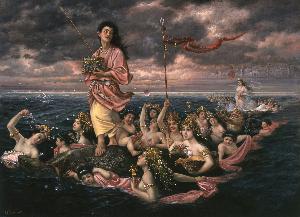Yamamoto Tamenosuke
Yamamoto Tamenosuke;Hosui Yamamoto
Place: Mino Province
Born: 1850
Death: 1906
Biography:
Yamamoto Tamenosuke, also known as Hosui Yamamoto, was a Japanese artist born in Mino Province in 1850. He first trained in the Nanga (Bunjinga) style before studying Western painting with Charles Wirgman and Goseda Horyu (1827–92) and under Antonio Fontanesi. This unique blend of traditional Japanese and Western art styles is reflected in his work, making him a prominent figure in Japanese art history.
Training and Career
Yamamoto's artistic journey took him to Paris, where he remained for over ten years and studied at the school of Fine Arts as Gérôme’s student from 1878 to 1887. During his time in Paris, he mixed with the city's artists and intelligentsia, supplying work for the illustrated edition of Robert de Montesquiou's Les chauves-souris. This experience had a profound impact on his artistic style, as seen in his later works.
Return to Japan and Teaching
Upon returning to Japan, Yamamoto opened a painting academy, the Seikokan, in Edo, teaching the French style of the Barbizon school. The academy was later renamed the Tenshin Dojo after his friend and fellow-artist Kuroda Seiki returned to Japan and joined him in teaching there, introducing the techniques of plein-air painting. This marked an important period in Yamamoto's career, as he played a significant role in introducing Western art styles to Japanese artists.
Notable Works
Among his notable works is Junishi (1892), a cycle of twelve oil paintings in the Western style based on the theme of the signs of the Chinese zodiac. This series showcases Yamamoto's mastery of Western art techniques and his ability to blend them with traditional Japanese themes. Key aspects of Yamamoto's work include:
- His unique blend of Nanga (Bunjinga) and Western art styles
- His experience studying in Paris and its impact on his artistic style
- His role in introducing Western art techniques to Japanese artists through his teaching
Legacy
Yamamoto's legacy can be seen in the many artists who followed in his footsteps, including those who studied at his academy. His work continues to be celebrated and studied by art enthusiasts around the world. For more information on Yamamoto Tamenosuke and other Japanese artists, visit Yamamoto Tamenosuke or explore the Tokyo National Museum collection. You can also learn more about the Nanga art movement on The Nanga Art Movement page. For a deeper understanding of Yamamoto's life and work, refer to his Wikipedia page.




